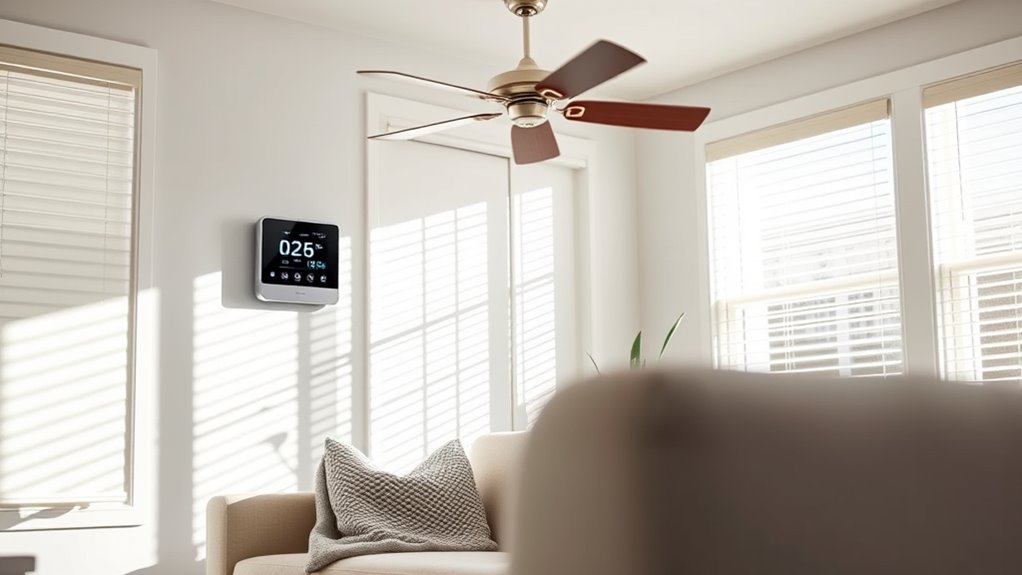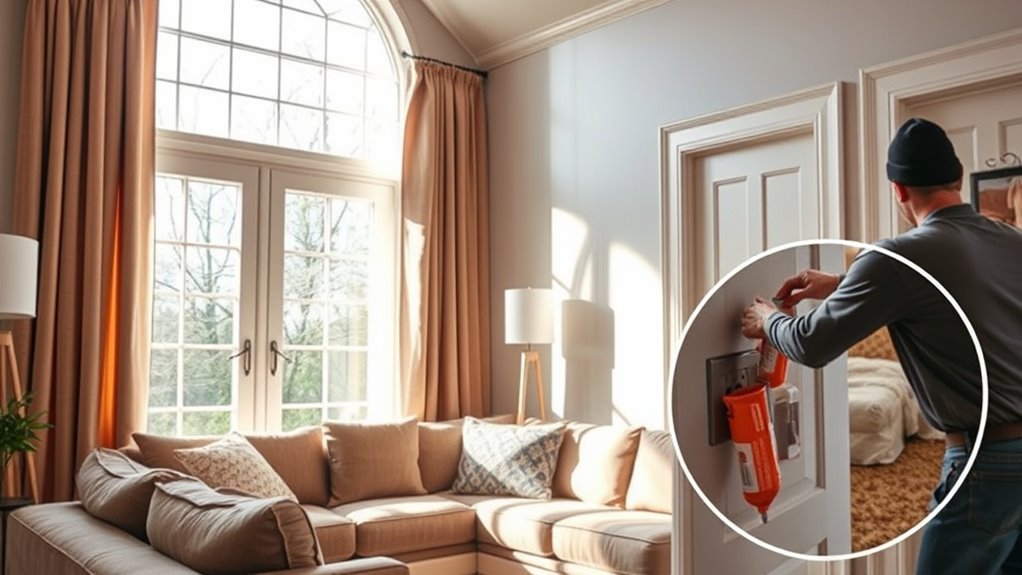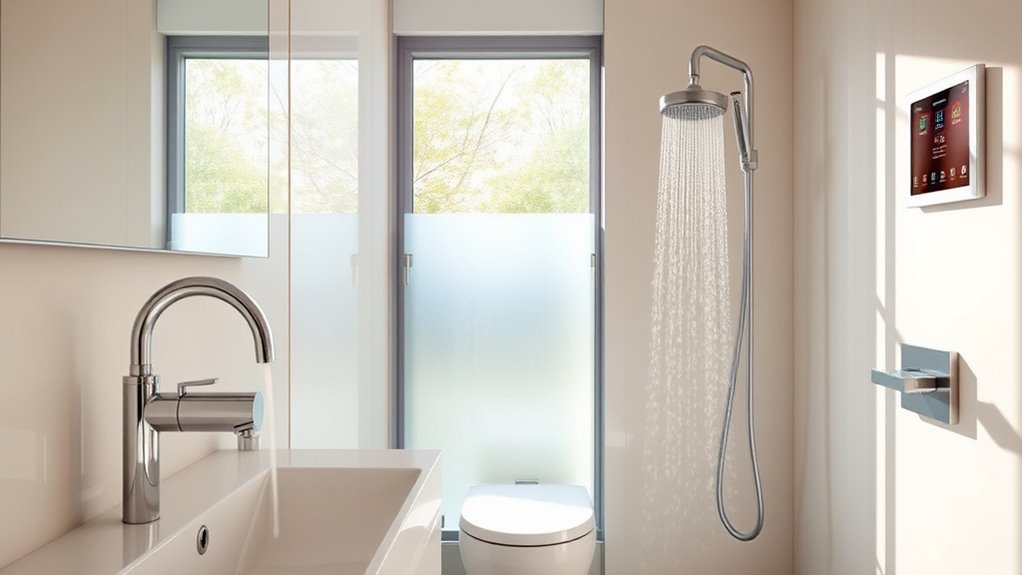To save energy at home, start by optimizing your heating and cooling systems with regular thermostat calibration and better insulation. Switch to energy-efficient LED lighting and use smart power strips or timers to prevent standby power waste. Seal gaps around doors, windows, and vents to improve insulation. Adopt water-saving fixtures and consider renewable options like solar panels to cut costs and your carbon footprint. Keep exploring these tips to discover more ways that can boost your home’s efficiency.
Key Takeaways
- Regularly calibrate thermostats and implement zone heating to improve HVAC efficiency and reduce energy waste.
- Replace traditional bulbs with LEDs and use smart power strips to cut electricity consumption.
- Install low-flow fixtures and utilize water sensors to conserve water and lower utility bills.
- Incorporate renewable energy solutions like solar panels and wind turbines to decrease reliance on non-renewable resources.
- Educate household members on sustainable practices and maintain appliances to maximize overall home energy efficiency.
Optimize Your Heating and Cooling Systems

To save energy and reduce your utility bills, it’s essential to optimize your heating and cooling systems. Start with thermostat calibration; an incorrectly calibrated thermostat can cause your system to run unnecessarily or ineffectively. Regularly check and adjust it to ensure accurate temperature readings. Additionally, consider zone heating—dividing your home into specific areas with separate thermostats or vents—so you only heat or cool occupied spaces. This targeted approach prevents energy waste in unused rooms. Proper calibration and zone heating work together to improve efficiency, keeping your home comfortable without overworking your HVAC system. Using thermostat calibration ensures your system operates at optimal efficiency, further reducing energy consumption. By maintaining your thermostat and implementing zone heating, you’ll optimize energy use and lower your heating and cooling costs effectively.
Switch to Energy-Efficient Lighting

Ever wondered how much energy your lighting consumes? Switching to energy-efficient lighting like LEDs can markedly cut your electricity bills. These bulbs offer dimming options, allowing you to adjust brightness and save power when full illumination isn’t needed. Plus, you can choose the right color temperature to create a cozy atmosphere or vibrant workspace, reducing unnecessary lighting use. Here’s a quick comparison:
| Bulb Type | Dimming Options | Typical Color Temperature |
|---|---|---|
| Incandescent | Limited | Warm (2700K) |
| CFL | Moderate | Neutral (3500K) |
| LED | Extensive | Adjustable (2200K-6500K) |
Upgrading your lighting not only saves energy but also enhances your home’s ambiance efficiently. Additionally, selecting the right dog names can reflect your personality and style, similar to how choosing energy-efficient lighting can define your home’s character.
Use Smart Power Strips and Timers

Smart power strips and timers help you cut energy waste effortlessly. By setting effective timers, you prevent devices from using power when you’re not using them, especially for things like chargers and entertainment systems. These tools also reduce phantom loads, saving you money and energy every day.
Benefits of Smart Strips
Have you considered how smart power strips can substantially reduce your energy bills? They enhance energy management by automatically turning off devices when not in use, preventing phantom loads. Here’s how they benefit you:
- Reduce wasted energy by cutting power to idle electronics.
- Simplify device automation, so your devices turn on or off at scheduled times.
- Save money with lower utility bills over time.
- Improve safety by preventing overheating and electrical hazards.
- Indoor air quality can be adversely affected by electrical devices left on unnecessarily, and smart strips help mitigate this risk by reducing device usage.
Setting Effective Timers
Using timers along with smart power strips can substantially enhance your home energy management. By setting precise timing schedules, you guarantee devices turn on and off when needed, preventing unnecessary power usage. For example, you can program your TV or computer to power down after a certain hour, reducing energy waste during inactive periods. Smart timers help you automate these routines, making energy conservation effortless. Consistent timing schedules also extend the lifespan of appliances and cut down on standby power. When used correctly, timers create a disciplined energy-saving system that minimizes waste without sacrificing convenience. Implementing this strategy allows you to efficiently control energy consumption, lowering your bills and reducing your environmental impact.
Reducing Phantom Loads
Did you know that many electronic devices continue to draw power even when they’re turned off? This is called appliance standby or phantom load. To cut down on this energy drain, consider using smart power strips and timers. Here’s how you can do it:
- Connect multiple devices, like your TV, gaming console, and sound system, to a smart strip.
- Schedule the timers to turn off power when devices aren’t in use, especially overnight.
- Check your electrical panel for outlets prone to standby power and unplug or automate them.
- Switch off or disconnect devices from the electrical panel when not needed for long periods.
These steps help reduce unnecessary energy consumption, saving you money and easing the load on your electrical system.
Improve Home Insulation and Sealing

Improving your home’s insulation and sealing gaps is one of the most effective ways to reduce energy consumption and lower utility bills. Start by adding window treatments like heavy curtains or shades, which help keep warm air inside during winter and block heat in summer. Check for gaps around doors, windows, and vents, and seal them with weatherstripping or caulk. Enhancing outdoor insulation—such as insulating your walls, attic, and pipes—can considerably boost your home’s energy efficiency. Proper insulation prevents heat from escaping in winter and keeps your home cooler in summer. Recognizing the importance of staying focused during these upgrades can help you complete projects efficiently and effectively. These simple upgrades make a big difference, reducing the workload on your heating and cooling systems, saving energy, and lowering your utility bills over time.
Adopt Water-Saving Technologies

You can start saving water by installing low-flow fixtures and choosing water-efficient appliances. Smart water sensors help you monitor usage and prevent waste. These simple upgrades make a big difference in reducing your home’s water consumption. Additionally, incorporating whole-house water filtration systems can improve water quality while supporting your conservation efforts.
Install Low-Flow Fixtures
Have you considered how installing low-flow fixtures can substantially reduce your water consumption? These fixtures limit water use without sacrificing performance. For example:
- Replace your shower head with a low-flow model to cut shower flow by up to 50%, saving gallons daily.
- Install faucet aerators to maintain pressure while reducing flow, saving water during everyday tasks.
- Switch to low-flow toilets, which use markedly less water per flush.
- Choose water-efficient kitchen and bathroom fixtures to maximize savings and reduce utility bills.
Use Smart Water Sensors
Ever wondered how technology can help you save water effortlessly? Smart water sensors make this possible by providing real-time water leak detection, alerting you immediately to any issues. These sensors monitor your water usage and send data to your phone, giving you clear usage analytics. With this information, you can identify patterns of waste and take steps to reduce unnecessary consumption. Installing smart water sensors is simple and cost-effective, yet they deliver significant water savings over time. By catching leaks early and understanding how you use water, you prevent costly damage and lower your water bills. Additionally, integrating water conservation features with other smart home devices can further enhance your home’s efficiency. Embracing this technology keeps your home efficient and environmentally friendly, making water conservation an effortless part of your daily routine.
Opt for Water-Efficient Appliances
Smart water sensors help you detect leaks early and understand your water usage patterns, making it easier to reduce waste. To maximize savings, choose water-efficient appliances that lower your overall water consumption. For example:
- Select dishwashers with high efficiency ratings to save water and energy.
- Opt for washing machines designed to reduce laundry water use without sacrificing cleaning power.
- Use faucet aerators and low-flow showerheads to cut down on daily water use.
- Regularly maintain appliances to guarantee they operate at peak efficiency.
- Be aware of water conservation practices to further enhance your home’s efficiency and reduce utility bills.
Incorporate Renewable Energy Solutions

Incorporating renewable energy solutions into your home is an effective way to reduce your carbon footprint and lower energy costs. Installing solar panels allows you to harness sunlight, generating clean electricity for your household. Wind turbines can also supplement your energy needs by capturing wind power, especially in breezy areas. These options not only cut expenses but also promote sustainability. Consider the table below to understand the benefits and challenges: ergonomics
Frequently Asked Questions
How Often Should I Service My HVAC System for Optimal Energy Efficiency?
You should service your HVAC system at least once a year to maintain ideal energy efficiency. Regular HVAC maintenance ensures your system runs smoothly, helps prevent breakdowns, and extends system longevity. Scheduling professional check-ups before peak seasons can catch issues early and keep your energy bills in check. Don’t wait until problems arise—annual maintenance is key to keeping your system efficient and lasting longer.
What Are the Best Smart Home Devices to Monitor Energy Consumption?
Ever notice how the right smart home devices can make energy savings feel effortless? You should consider a smart thermostat, which learns your schedule and adjusts temperature accordingly, saving you money. Pair it with an energy monitor to track real-time usage and identify waste. Together, these devices give you visibility and control, helping you optimize your energy consumption effortlessly. It’s like having a personal energy coach right in your home.
How Can I Identify Leaks and Drafts in My Home Effectively?
You can identify leaks and drafts by inspecting your insulation and checking window sealing. Start with an insulation inspection around doors and windows; if you notice gaps or uneven insulation, seal them. Use a candle or your hand to feel for drafts near windows and door frames. Also, check for cracks or gaps in window seals and reapply weatherstripping or caulk as needed to keep your home airtight and energy-efficient.
Are There Government Incentives for Installing Renewable Energy Systems?
Yes, you can take advantage of government incentives like solar grants and tax credits when installing renewable energy systems. These programs often help reduce your upfront costs and make switching to solar or wind power more affordable. To maximize benefits, check your local and federal programs, and guarantee your installation qualifies. Taking these steps makes it easier to go green and save money on energy bills long-term.
What Are Cost-Effective Ways to Upgrade Old Home Appliances for Energy Savings?
You can save money by comparing appliances before upgrading. Look for ENERGY STAR-rated models, which are more energy-efficient and reduce your utility bills. Upgrading old appliances offers clear benefits like lower energy consumption, fewer repairs, and better performance. Focus on the most used appliances first, such as your refrigerator or washer. This strategic approach maximizes savings and guarantees you get the best value from your upgrade investments.
Conclusion
By implementing these tips, you’ll cut energy costs and make your home more eco-friendly. Think of it like upgrading from a candle to a modern electric lamp—you’ll enjoy brighter, more efficient living. Remember, saving energy isn’t just a trend; it’s your ticket to a greener planet. So, don’t wait for a knight in shining armor—take charge now and make your home a shining example of energy wisdom.










